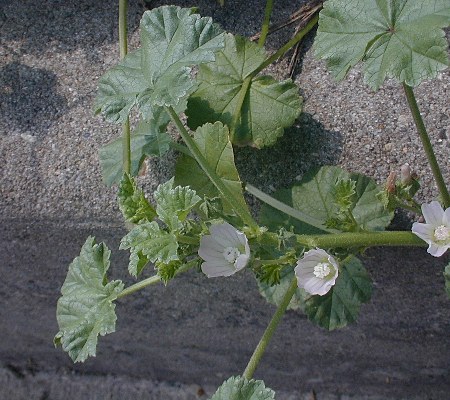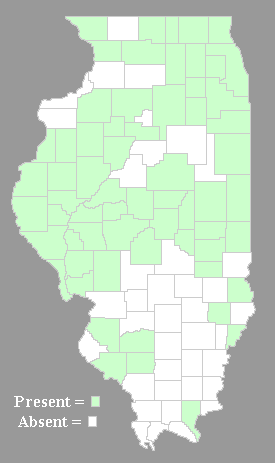Description: This plant species is an annual that forms a branching vine up to 3' in length. The stems have abundant white hairs. The alternate leaves occur on long petioles along the stems. The leaves are up to 2½" long and 3" across, while the petioles are about twice as long as the leaves. The palmate leaves are orbicular to kidney-shaped (reniform), with 5 or more shallow lobes, and a crenate margin. They are deeply indented at the base and often have short hairs across the upper or lower surface.

Occasionally, a
short flowering stalk (peduncle) about 1" long will occur above the
leaf axils, each stalk producing 1-3 flowers. Each flower is about ¾"
across and has 5 slightly notched petals. The petals are light violet
or white, often with pale violet lines along their length. The green
calyx has 5 lobes with ovate tips that are about one-half the length of
the petals. In the center of the flower, there is a central
reproductive column with single pistil and numerous stamens appressed
together. In the absence of a major disturbance, the blooming period
usually occurs during the summer and lasts about 2-3 months. However,
some plants will bloom during late spring or early fall. Each flower is
replaced by a fruit that has a wheel-like shape in which the flat seeds
are aligned in a circular row. The outer edge of these seeds is often
hairy. The root system consists of a taproot. This plant spreads by
reseeding itself.
Cultivation:
The Common Mallow occurs in sunny places that are usually mesic to
slightly dry. Growth is more luxuriant in fertile loamy soil, but it is
adaptable to different soil types. During a drought, some of the lower
leaves on the vine may wither away. This plant can survive irregular
mowing or occasional attacks from a weed-whacker.
Range & Habitat:
The non-native Common Mallow is occasional to common in most areas of
central and
northern Illinois, while in southern Illinois it is often uncommon or
absent. Habitats include cropland, abandoned fields, farm lots, vacant
lots, areas along roads and railroads, edges of yards, and gardens.
Highly disturbed areas are preferred, while the invasive potential of
this species to natural habitats is low. This species is adventive from
Europe.
Faunal Associations:
The nectar and pollen of the flowers attract primarily bees, including
honeybees, bumblebees, little carpenter bees (Ceratina spp.),
cuckoo
bees (Nomada spp.), mason bees (Osmia spp.),
green metallic bees, and
other Halictid bees. Other
visitors of the flowers include miscellaneous flies
and butterflies, especially Pieris rapae
(Cabbage
White). The caterpillars of some Lepidoptera feed on mallows, including
Anomis erosa (Yellow Scallop Moth), Pyrgus
communis (Common Checkered Skipper), and the butterflies Strymon
melinus (Gray Hairstreak) and Vanessa cardui
(Painted Lady). The foliage is non-toxic and probably eaten by rabbits.
Birds apparently make little use of the seeds.
Photographic Location:
At the edge of a yard along a city sidewalk in Urbana, Illinois. The
day-blooming flowers in the above photograph are only partially open.
Comments:
This is one of the weedy members of the Mallow family. Most mallows are
erect perennial plants with large flowers, while Common Mallow is an
annual vine with average-sized flowers. In open areas, it tends to form
a mat of leaves and stems across the ground that can extend several
feet. It has a similar appearance to another introduced species, Malva
rotundifolia (Dwarf Mallow). The Dwarf Mallow has smaller
flower petals that are only slightly larger than the lobes of the
calyx, while the flower petals of the Common Mallow are twice the
length of the calyx lobes. The Dwarf Mallow is less common in Illinois.